Keratin gene mutations in disorders of human skin and its appendages
- PMID: 21176769
- PMCID: PMC3142884
- DOI: 10.1016/j.abb.2010.12.019
Keratin gene mutations in disorders of human skin and its appendages
Abstract
Keratins, the major structural protein of all epithelia are a diverse group of cytoskeletal scaffolding proteins that form intermediate filament networks, providing structural support to keratinocytes that maintain the integrity of the skin. Expression of keratin genes is usually regulated by differentiation of the epidermal cells within the stratifying squamous epithelium. Amongst the 54 known functional keratin genes in humans, about 22 different genes including, the cornea, hair and hair follicle-specific keratins have been implicated in a wide range of hereditary diseases. The exact phenotype of each disease usually reflects the spatial expression level and the types of mutated keratin genes, the location of the mutations and their consequences at sub-cellular levels as well as other epigenetic and/or environmental factors. The identification of specific pathogenic mutations in keratin disorders formed the basis of our understanding that led to re-classification, improved diagnosis with prognostic implications, prenatal testing and genetic counseling in severe keratin genodermatoses. Molecular defects in cutaneous keratin genes encoding for keratin intermediate filaments (KIFs) causes keratinocytes and tissue-specific fragility, accounting for a large number of genetic disorders in human skin and its appendages. These diseases are characterized by keratinocytes fragility (cytolysis), intra-epidermal blistering, hyperkeratosis, and keratin filament aggregation in severely affected tissues. Examples include epidermolysis bullosa simplex (EBS; K5, K14), keratinopathic ichthyosis (KPI; K1, K2, K10) i.e. epidermolytic ichthyosis (EI; K1, K10) and ichthyosis bullosa of Siemens (IBS; K2), pachyonychia congenita (PC; K6a, K6b, K16, K17), epidermolytic palmo-plantar keratoderma (EPPK; K9, (K1)), monilethrix (K81, K83, K86), ectodermal dysplasia (ED; K85) and steatocystoma multiplex. These keratins also have been identified to have roles in apoptosis, cell proliferation, wound healing, tissue polarity and remodeling. This review summarizes and discusses the clinical, ultrastructural, molecular genetics and biochemical characteristics of a broad spectrum of keratin-related genodermatoses, with special clinical emphasis on EBS, EI and PC. We also highlight current and emerging model tools for prognostic future therapies. Hopefully, disease modeling and in-depth understanding of the molecular pathogenesis of the diseases may lead to the development of novel therapies for several hereditary cutaneous diseases.
Copyright © 2010 Elsevier Inc. All rights reserved.
Figures




References
-
- Tabolli S, Pagliarello C, Uras C, Di Pietro C, Zambruno G, Castiglia D, Sampogna F, Abeni D. Family burden in epidermolysis bullosa is high independent of disease type/subtype. Acta Derm Venereol. 2010;90:607–611. - PubMed
-
- Pagliarello C, Tabolli S. Factors affecting quality of life in epidermolysis bullosa. Expert Rev Pharmacoecon Outcomes Res. 2010;10:329–338. - PubMed
-
- Gu X, Xu F, Wang X, Gao X, Zhao Q. Molecular cloning and expression of a novel CYP26 gene (cyp26d1) during zebrafish early development. Gene Expr Patterns. 2005;5:733–739. - PubMed
Publication types
MeSH terms
Substances
Grants and funding
LinkOut - more resources
Full Text Sources
Other Literature Sources
Medical
Research Materials

